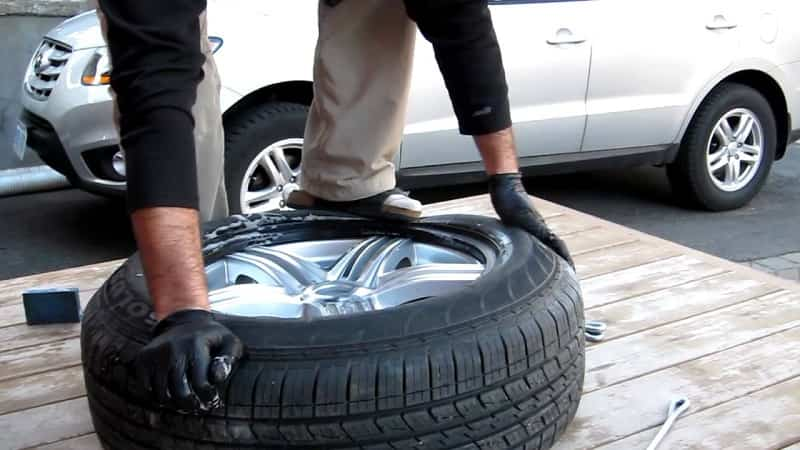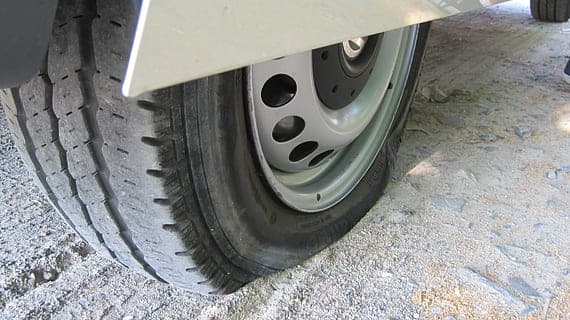You will certainly be very worried if your car has a problem and you have to remove the tires. After fixing the problem, It's not easy to put the tire back on the rim.
There are practically countless ways to advise how to fit a tire to the rim, either by machine or by hand. This is also what makes many people interested to find out if a person who is not an auto mechanic or a professional can do this by himself at home.
So, how to put a tire back on the rim? You need to use fire to do this, which requires high safety.
- Step 1: Put the rim inside the tire
- Step 2: Spray the starter fluid around the bead of the tire
- Step 3: Use fire to put the rim on the tire
- Step 4: Pump air into the tire
The following article will guide you through the steps and important notes to handle this error effectively.
Contents
Necessary Tools
Before starting a job, especially using a lot of tools like putting a tire back on the rim, you need to prepare:
- A Starter fluid: This substance is very volatile, and it will help you start the engine
- Parts cleaner
- Anti-rust, moisture-proof WD-40: They allow you to dry electrical circuits.
- Lighter or match to ignite
- Fire Extinguisher: Extinguish the fire if an explosion occurs
How to Put a Tire Back on the Rim?

Below, we will describe the steps in the most detailed and complete way. Each step will need specific notes and manipulations. In addition, there will be notes for each stage. Check it now!
Step 1: Put the rim inside the tire
This step is the first step in all your processes. What you need to do is make sure they are smooth. You need to raise your wheel part off the ground, which will make it easier for you to disassemble with the help of a lifting tool.
At the same time, you should only re-install the wheel in the vehicle when you have fixed the problems encountered. Errors that you need to improve after removing them. Make sure you've selected it all and don't have any doubts.
There are a number of causes leading to tire removal such as cracked or blown tires, punctured tires due to obstacles while moving. After the repair, you need to put the rim on the tire. Moreover, your car will be safe with a perfect wheel.
Step 2: Spray the starter fluid around the bead of the tire
At this 2nd step, you will get a bottle of Fluid. They are often used as a support tool when you have difficulty starting the engine or cold. They will do the job perfectly under normal conditions.
Then, you use the spray in a circular direction around your wheel. In this next operation, carefully spray the liquid into the space between the sidewall tire and the rim. However, you should also ensure you're not taking too much of it.
The reason for adequate fluid is that too much of them can cause sidewall problems and even lead to failure, damage, and replacement.
At the same time, you should also spray on each ground in one line just below the edge. The effect of this activity is to help limit fires while you use matches/lighters and Starter Fluid.
Moreover, when using the above liquid, you need to be extremely careful when spraying on the wheels. Due to their flammability and flammability that can cause a fire, it isn't easy even to end it.
Therefore, you need to equip yourself with a fire extinguisher and the skills to manipulate them before assembling.
Step 3: Use fire
The third step in the process needs to be as soon as finishing step 2. This action will prevent the tire's granules from drying out and the solution from evaporating.
Then you start lighting it using matches, lighters, or other sources of fire. You light up the fluid associated with the components above from the ground. At the same time, it will help keep you safer in potentially explosive conditions.
But don’t worry your goal is to just light it up and then turn it off as soon as you can and that smoke is going to fill the tire, so you can do it a couple of times.
In addition, fire causes the air to expand rapidly, at the same time, the particles will move along the wheel and return to their original position.
After the tire bead is exposed to fire and when you hear the sound within 2 seconds. At this point, you need to put out the fire immediately. The faster you act, the sooner the fire is extinguished.
Moreover, the fire extinguisher at this time will also come into play.
Step 4: Pump air into the tire
When you hear the popping sound, it is time to end with the tire in place on the rim.
You need to use an inflator and pump outside air into your tires.
When the tire inflates, you can start or continue your journey on the vehicle that has changed the tire.
This method is standard when replacing a wheel on a rim, especially when you don't need a repair shop.
If you can't replace them yourself and are close to a store, you should take them out there. The staff will support and replace you. Then the safety will be more assured.
Side effects might happen

When taking any action, you need to be careful with what happens. The same goes for changing car tires. The effect you may experience is called Pyrolysis.
They are the decomposition process of substances by the effect of high temperature and long time. Likewise, Pyrolysis will overheat the tires, create layer pressure, and even blow the tire.
In addition, the wheel is hot due to the inflator. It can weld near or above the wheel and cause breakage at high temperatures.
It is also the reason described in the above section when it is necessary to pump the fire immediately. After you hear the sound, you only have two seconds to start putting out the fire.
This chemical phenomenon will occur even when a low temperature of 183 - 185 degrees Celsius. In particular, they do not need to use oxygen to perform. They continue to develop in the tire, even after removing the source of fire and heat.
This problem is difficult to detect and occurs from some seconds to several hours later. They push the tire pressure to 7000 kPa.
With such class pressure, people around the event may suffer some problems and damage their health if standing close.
Therefore, you need to ensure safety in all steps of this process. It will be awful if someone gets hurt, even if you are not driving on the road.
Preventive measures
- Do not use fire to inflate tires: This operation can cause a tire explosion if filled with air. And only do it when you can't find an alternative process at all.
- Temperature: When disassembling and performing repairs, you must leave the tire at room temperature and help it cool. Only then can you do the reassembly. Also, make sure they are complete and safe before returning to the car.
- If it is not safe, keep it away from the tire: Isolate it if you have doubts about tire problems and they are not safe for you. You and others have not been in close contact with them for 24 hours. It ensures your safety, your loved ones, and most of all, children. After the above time, you can remove and check.
- Pyrolysis: This phenomenon is relevant for heavy trucks. Before operating, you need to use a pneumatic pump to inflate the tire.
- No face contact: You should keep your face away when inflating tires; it will help you be safer.
- Maintenance: As with any car, you need to have it serviced periodically. Tires, wheels, and brakes are subject to friction when moving, so care is more frequent.
What to do if the above method does not work?
This problem is often when your vehicle is traveling on uneven surfaces. Here are the steps for you:
Step 1: Keep Calm
All you need to do now is stay as calm as possible. Things will get better when you fix it.
Step 2: Try Parking At A Safe Spot If You Can
Next, try to move further to a safer place like the curb while still ensuring your rims. Moving to a nearby location is ideal. However, if you can't do that, warn everyone on the road, so they know and avoid it.
Step 3: Remove The Tire
Once more stable, you need to remove the tire and place it on the ground. At the same time, flatten the tire and tighten it with the ratchet belt.
Step 4: Pump Air
As described above, you will inflate the tire until you hear a sound and make sure the tire is in place.
Always carry tools in the car to make sure you can adapt and handle the best if you encounter this situation.
You can see more instructions here: Video created by Garage Boys
Conclusion
Thus, the article has provided the steps in putting a tire back on the rim. Hopefully, you can do this activity yourself.
Please note that using fire is convenient and easy but also extremely dangerous. You must ensure your safety.
Car repair shops can also help you do this assembly very well for a small cost.
I’m Ivo Gievski, the content writer for Tireer. We built our website with over 15 years of experience and extensive research in the automotive and technology sectors. My dedication to delivering high-quality content is unwavering, and I strive to continuously hone my skills to stay ahead of industry trends and provide readers with informative, engaging, and valuable insights.